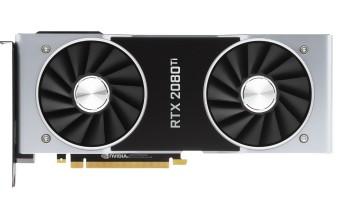 In retrospect, we admit that if Nvidia's generation 10 seemed to have been out for ages (with a downright impressive lifespan on the GPU market), these cards are far from out of date, and allow you to still run all modern productions without breaking a sweat. The reason for this renewal is therefore the arrival of the famous RTX, a new way of rendering graphics that requires specific tools, hence this 20 series. If we will let you take a look at our article which explains how it works the RTX, and the interest it presents in game, let us detail what is hidden in the bowels of this RTX 2080 Ti. Where the GTX 1080Ti embeds the GP 102 (the Titan chip), the RTX 2080 Ti embeds the TU 102 (nothing to do with a Tupolev), a new Turing architecture chip, which is none other than the large version audience of the Volta architecture found on the pro Tesla and Quadro cards. Engraved in 12nm FinFET by the TSMC foundry, this chip does not really offer a very significant gain compared to the 16nm of the previous generation, which explains stagnant power consumption, and which even increases a little since we go from 250W of TDP for the 1080 Ti at 260W for this RTX 2080 Ti. No, the big novelty of the Turing architecture consists in the presence of new specialized calculation units.
In retrospect, we admit that if Nvidia's generation 10 seemed to have been out for ages (with a downright impressive lifespan on the GPU market), these cards are far from out of date, and allow you to still run all modern productions without breaking a sweat. The reason for this renewal is therefore the arrival of the famous RTX, a new way of rendering graphics that requires specific tools, hence this 20 series. If we will let you take a look at our article which explains how it works the RTX, and the interest it presents in game, let us detail what is hidden in the bowels of this RTX 2080 Ti. Where the GTX 1080Ti embeds the GP 102 (the Titan chip), the RTX 2080 Ti embeds the TU 102 (nothing to do with a Tupolev), a new Turing architecture chip, which is none other than the large version audience of the Volta architecture found on the pro Tesla and Quadro cards. Engraved in 12nm FinFET by the TSMC foundry, this chip does not really offer a very significant gain compared to the 16nm of the previous generation, which explains stagnant power consumption, and which even increases a little since we go from 250W of TDP for the 1080 Ti at 260W for this RTX 2080 Ti. No, the big novelty of the Turing architecture consists in the presence of new specialized calculation units.
A CARD THAT HAS THE MONOPOLY OF HEART?
 We are seeing the arrival of RT units dedicated to Ray Tracing (the famous RTX) and whose objective will be to optimally calculate the graphic effects that take advantage of this technology, but we will come back to this below. The other novelty is the presence of Tensor Core, units specially designed to run artificial intelligence as part of DLSS. This acronym actually hides a new anti-aliasing system that uses AI to optimize its performance. The idea is that the more users play a given title, the more the AI will find tricks to obtain an optimal result while minimizing the resources used. Of course, it is currently impossible to quantify the impact of this system, which explains why the performance gains are not mentioned in this test. Finally, we should also mention the arrival of the NVlink (whose socket is hidden behind a cover) which now replaces the SLi for multi-GPU configurations. Without having been able to test this system (only one card available), we can tell you that it only allows you to connect two cards (instead of 4 with SLi) but that it should allow significant efficiency gains. Indeed, where SLi required having a main card that delegated tasks to slave cards, NVlink allows for more intelligent task sharing, which should increase the performance gains provided by multi-GPU solutions. However, given the glaring lack of support for this type of installation in games, we understand that Nvidia has not really bet on this feature.
We are seeing the arrival of RT units dedicated to Ray Tracing (the famous RTX) and whose objective will be to optimally calculate the graphic effects that take advantage of this technology, but we will come back to this below. The other novelty is the presence of Tensor Core, units specially designed to run artificial intelligence as part of DLSS. This acronym actually hides a new anti-aliasing system that uses AI to optimize its performance. The idea is that the more users play a given title, the more the AI will find tricks to obtain an optimal result while minimizing the resources used. Of course, it is currently impossible to quantify the impact of this system, which explains why the performance gains are not mentioned in this test. Finally, we should also mention the arrival of the NVlink (whose socket is hidden behind a cover) which now replaces the SLi for multi-GPU configurations. Without having been able to test this system (only one card available), we can tell you that it only allows you to connect two cards (instead of 4 with SLi) but that it should allow significant efficiency gains. Indeed, where SLi required having a main card that delegated tasks to slave cards, NVlink allows for more intelligent task sharing, which should increase the performance gains provided by multi-GPU solutions. However, given the glaring lack of support for this type of installation in games, we understand that Nvidia has not really bet on this feature.
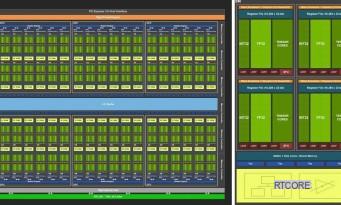 In terms of construction, know that the Tu 102 chip offers an honest evolution compared to the GP 102 of the GTX 1080 Ti. We have 4 computation units (CUDA Cores) instead of 352 and 3 texture units instead of 584. now GDDR272 instead of GDDR224X, which allows a frequency gain (11 MHz instead of 6) and therefore a bandwidth of 5 GB/s instead of 1 GB/s, all with a bus that rest of 750 bits. In terms of frequencies, we remain on comparable figures between the two heavyweights with 1 Mhz in base frequency and 375 Mhz in boost on the RTX while the 616Ti offered 484 Mhz in base and 352 Mhz in boost. Like its predecessor, the 1Ti features Nvidia's GPU Boost which oscillates clocks based on GPU temperature, meaning these numbers can be well exceeded. On our test copy, we were able to find a frequency of 350 Mhz in stabilized gaming at full load on the GPU, knowing that we saw a peak at 1 Ghz when the chip was still cold. In terms of temperatures, our Founder's Edition is quite surprising since if the thermal maximum is set at 635°C by Nvidia, the new heatsink allows for nice gains by simply mounting the fans. As you can see in the images, the chameleon firm has finally ditched its blower design (which draws air into the case to expel it out the back) with a single radial fan for a more common option among assemblers. , namely a pair of axial fans.
In terms of construction, know that the Tu 102 chip offers an honest evolution compared to the GP 102 of the GTX 1080 Ti. We have 4 computation units (CUDA Cores) instead of 352 and 3 texture units instead of 584. now GDDR272 instead of GDDR224X, which allows a frequency gain (11 MHz instead of 6) and therefore a bandwidth of 5 GB/s instead of 1 GB/s, all with a bus that rest of 750 bits. In terms of frequencies, we remain on comparable figures between the two heavyweights with 1 Mhz in base frequency and 375 Mhz in boost on the RTX while the 616Ti offered 484 Mhz in base and 352 Mhz in boost. Like its predecessor, the 1Ti features Nvidia's GPU Boost which oscillates clocks based on GPU temperature, meaning these numbers can be well exceeded. On our test copy, we were able to find a frequency of 350 Mhz in stabilized gaming at full load on the GPU, knowing that we saw a peak at 1 Ghz when the chip was still cold. In terms of temperatures, our Founder's Edition is quite surprising since if the thermal maximum is set at 635°C by Nvidia, the new heatsink allows for nice gains by simply mounting the fans. As you can see in the images, the chameleon firm has finally ditched its blower design (which draws air into the case to expel it out the back) with a single radial fan for a more common option among assemblers. , namely a pair of axial fans.
THE FRESHEST GEFORCE?
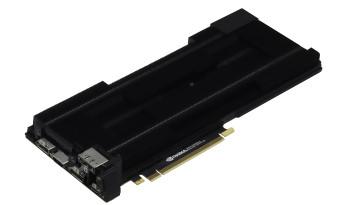 This solution allows a big gain in efficiency, especially since unlike assembler cards which are content to use heat pipe radiators (rods which take the heat from the chip to the fins of the heatsink), Nvidia has renewed its vapor chamber. This system, used on the old Founder's Edition cards, therefore uses a closed volume in which a liquid evaporates on contact with the hot chip, before condensing at the top of the chamber, dissipating a large amount of energy in the process. Since evaporation is the physical phenomenon that dissipates heat most efficiently (that's why you get cold when you get soaked from the shower), this vapor chamber offers performance worthy of the largest heat pipe radiators, while minimizing the weight of the card and the bulk in the case. As you have understood, if the Founder's Edition were until then models reserved for fans of blower design, performance enthusiasts turning to assembler products (MSI, EVGA, ASUS, ZOTAC, etc.), this is not no longer the case. The RTX 2080 Ti offers a cooling solution that is largely as efficient as the competition, and probably better than the systems used on entry-level cards. In a nutshell, the Founder's Edition is now a choice to consider for performance enthusiasts.
This solution allows a big gain in efficiency, especially since unlike assembler cards which are content to use heat pipe radiators (rods which take the heat from the chip to the fins of the heatsink), Nvidia has renewed its vapor chamber. This system, used on the old Founder's Edition cards, therefore uses a closed volume in which a liquid evaporates on contact with the hot chip, before condensing at the top of the chamber, dissipating a large amount of energy in the process. Since evaporation is the physical phenomenon that dissipates heat most efficiently (that's why you get cold when you get soaked from the shower), this vapor chamber offers performance worthy of the largest heat pipe radiators, while minimizing the weight of the card and the bulk in the case. As you have understood, if the Founder's Edition were until then models reserved for fans of blower design, performance enthusiasts turning to assembler products (MSI, EVGA, ASUS, ZOTAC, etc.), this is not no longer the case. The RTX 2080 Ti offers a cooling solution that is largely as efficient as the competition, and probably better than the systems used on entry-level cards. In a nutshell, the Founder's Edition is now a choice to consider for performance enthusiasts.
 Precisely, speaking of performance, know that the RTX 2080Ti defends itself downright well in the tests (with an i7-8700K on an ASUS ROG STRIX CM, which seems to us representative of the high-end PC of this end of 2018). Overall we note a performance gain of about 30% compared to the GTX 1080Ti, which is rather good news, even if this difference remains in the average (high) of what we see on a change of architecture . Of course, for 1080p gaming, buying this GPU is completely pointless, which is why we conducted all of our tests at 4K. At this resolution, which has traditionally been a problem for GPUs, the GTX 2080 Ti impresses. Almost all of our games run at 4K 60 FPS without flinching, with plenty of options enabled. On Battlefield V in Ultra 4K, we get an average of 75FPS in game, even in War Stories like Skirmishers where the flying leaves undermine older GPUs. On Shadow of the Tomb Raider, we get 52 FPS on the benchmark in Highest preset, and 64 FPS in High, still with a resolution of 3840x2160. With GTA V, we get 54FPS in ultra with the PCSS activated, while we go up to 68FPS by setting the options to High.
Precisely, speaking of performance, know that the RTX 2080Ti defends itself downright well in the tests (with an i7-8700K on an ASUS ROG STRIX CM, which seems to us representative of the high-end PC of this end of 2018). Overall we note a performance gain of about 30% compared to the GTX 1080Ti, which is rather good news, even if this difference remains in the average (high) of what we see on a change of architecture . Of course, for 1080p gaming, buying this GPU is completely pointless, which is why we conducted all of our tests at 4K. At this resolution, which has traditionally been a problem for GPUs, the GTX 2080 Ti impresses. Almost all of our games run at 4K 60 FPS without flinching, with plenty of options enabled. On Battlefield V in Ultra 4K, we get an average of 75FPS in game, even in War Stories like Skirmishers where the flying leaves undermine older GPUs. On Shadow of the Tomb Raider, we get 52 FPS on the benchmark in Highest preset, and 64 FPS in High, still with a resolution of 3840x2160. With GTA V, we get 54FPS in ultra with the PCSS activated, while we go up to 68FPS by setting the options to High.
THE QUEEN OF 4K
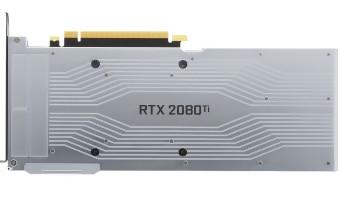 Forza Horizon 4 sends even more of the dream with between 81 and 89 FPS in 4K HDR there too with the settings fully. For its part, F1 2018 runs at 95FPS in ultra having run the benchmark on SPA in pouring rain. Continuing with the racing games on Assetto Corsa Competizione, and after several laps on different circuits in the middle of a storm, we obtain 80 FPS with the Epic setting. Finally, on the oldest DOOM, we release more than 100FPS all options fully under OpenGL. The story is no different when using 3D Mark with 7887 points on the Fire Strike Ultra 4K, and 5638 points on the Time Spy 4K which uses DirectX 12. , we were able to exceed 8000 points on the Fire Strike Ultra quite easily, since the card exceeds 2Ghz without even having to increase the voltages. The overclocking potential is therefore very present, even if we prefer to recommend models with liquid cooling for those who really want to hope for very significant gains. In addition, we must point out that several users have had problems with these cards, the memory chips not supporting the heat released by the GPU. In our case, and without having tried to push the card to its limits, we did not encounter any problem, while the nuisances linked to Coil Whine which could have been mentioned on release seem to have been corrected by the latest drivers.
Forza Horizon 4 sends even more of the dream with between 81 and 89 FPS in 4K HDR there too with the settings fully. For its part, F1 2018 runs at 95FPS in ultra having run the benchmark on SPA in pouring rain. Continuing with the racing games on Assetto Corsa Competizione, and after several laps on different circuits in the middle of a storm, we obtain 80 FPS with the Epic setting. Finally, on the oldest DOOM, we release more than 100FPS all options fully under OpenGL. The story is no different when using 3D Mark with 7887 points on the Fire Strike Ultra 4K, and 5638 points on the Time Spy 4K which uses DirectX 12. , we were able to exceed 8000 points on the Fire Strike Ultra quite easily, since the card exceeds 2Ghz without even having to increase the voltages. The overclocking potential is therefore very present, even if we prefer to recommend models with liquid cooling for those who really want to hope for very significant gains. In addition, we must point out that several users have had problems with these cards, the memory chips not supporting the heat released by the GPU. In our case, and without having tried to push the card to its limits, we did not encounter any problem, while the nuisances linked to Coil Whine which could have been mentioned on release seem to have been corrected by the latest drivers.
In game, and in the middle of the action, we must admit that we do not necessarily realize the effects of RTX, but when we pose to admire the reflections, the result is truly mind-blowing, and we dropped our jaws more than once, while we were shot down many times by dint of detailing the puddle at our feet instead of watching the opposing players.
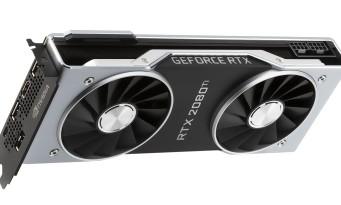 Let's get back to the famous RTX here. This system is currently only present on Battlefield V (and for only a few days), our tests are of course limited, but we can still draw several conclusions. If we obtain 75 FPS while playing in Ultra 4K, by activating the DXR (Direct Ray Tracing) option, the framerate immediately breaks the figure around 30FPS, or even less (drops at 15 frames / sec) when we attack to some scenes filled with dead leaves flying in War Story Skirmishers. By lowering the intensity of the Ray Tracing we regain framerate, with 35-40 FPS in medium and 60FPS in low, but at this level the quality of the reflections is no longer really up to par. You can also drop 4K and switch to 1080p, which instantly restores a framerate of 75FPS. If these figures are not really representative, they nevertheless allow us to confirm that this graphic option remains particularly resource-intensive, which is not surprising given the youth of the technology. We remember that the story was the same in 2007 when Mirror's Edge arrived with the PhysX. As you have understood, we will have to wait for Nvidia and DICE to optimize the software on their own, but we do not despair that performance will improve greatly over time. DRX will also have to be experienced in other games, players are still waiting for the update that will activate the option in Shadow of the Tomb Raider, while Metro Exodus should be talking about the powder next February, which will already give developers more time to optimize effects using ray tracing. In game, and in the middle of the action, we must admit that we do not necessarily realize the effects of RTX, but when we pose to admire the reflections, the result is truly mind-blowing, and we dropped our jaws more than once, while we were shot down many times by dint of detailing the puddle at our feet instead of watching the opposing players.
Let's get back to the famous RTX here. This system is currently only present on Battlefield V (and for only a few days), our tests are of course limited, but we can still draw several conclusions. If we obtain 75 FPS while playing in Ultra 4K, by activating the DXR (Direct Ray Tracing) option, the framerate immediately breaks the figure around 30FPS, or even less (drops at 15 frames / sec) when we attack to some scenes filled with dead leaves flying in War Story Skirmishers. By lowering the intensity of the Ray Tracing we regain framerate, with 35-40 FPS in medium and 60FPS in low, but at this level the quality of the reflections is no longer really up to par. You can also drop 4K and switch to 1080p, which instantly restores a framerate of 75FPS. If these figures are not really representative, they nevertheless allow us to confirm that this graphic option remains particularly resource-intensive, which is not surprising given the youth of the technology. We remember that the story was the same in 2007 when Mirror's Edge arrived with the PhysX. As you have understood, we will have to wait for Nvidia and DICE to optimize the software on their own, but we do not despair that performance will improve greatly over time. DRX will also have to be experienced in other games, players are still waiting for the update that will activate the option in Shadow of the Tomb Raider, while Metro Exodus should be talking about the powder next February, which will already give developers more time to optimize effects using ray tracing. In game, and in the middle of the action, we must admit that we do not necessarily realize the effects of RTX, but when we pose to admire the reflections, the result is truly mind-blowing, and we dropped our jaws more than once, while we were shot down many times by dint of detailing the puddle at our feet instead of watching the opposing players.
TO BUY OR NOT?
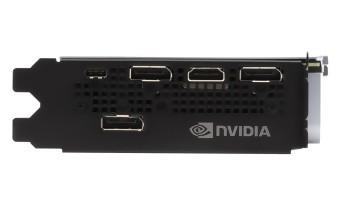 As always, the question of purchase remains a personal decision that greatly depends on your financial means, the use you make of your GPU, and the hardware you already own. If you play in 4K, we can only recommend the heavy investment required by the Geforce RTX 2080Ti (1259€ in the Founder's Edition version) as the performance is amazing. If the price increase will of course make 90% of players wince (the 1080Ti was at 824€), this card must be considered as the replacement for the Titan, and as such, the price is more reasonable since the Titan Xp was sold for €1349. Anyway, this card has such indisputable advantages for 4K gaming that we can only recommend it, support for RTX and DLSS being almost bonus features at this level. In addition, at this resolution, the targeted customers almost all have 1080Tis, the resale of which lowers the amount to be taken out at the time of purchase, the price of these old GPUs remaining quite high at the present time. In the case of gaming at 1440p, the question is much more delicate. Indeed, the GTX 1080Ti remains excellent and offers a better price/performance ratio, especially on the second-hand market. In this case, your sensitivity to new technologies remains a much more determining factor, with RTX and DLSS becoming arguments whose weight is more important in the balance, even if the price is steep. Finally, for players who have stuck to 1080p (the majority), the investment is not really worth the candle (and the classic RTX 2080 and 2070 are less expensive options), unless you have the means and the want to have fun with the RTX, since at this resolution, the RTX 2080 Ti can already provide a very correct framerate and which will improve with the patches. If you're not interested in having retina-busting reflections, move on, and know that thanks to the release of these GeForce RTXs, and thanks to the collapse of the cryptocurrency mining market, the price of the GTX 10 series is in free fall.
As always, the question of purchase remains a personal decision that greatly depends on your financial means, the use you make of your GPU, and the hardware you already own. If you play in 4K, we can only recommend the heavy investment required by the Geforce RTX 2080Ti (1259€ in the Founder's Edition version) as the performance is amazing. If the price increase will of course make 90% of players wince (the 1080Ti was at 824€), this card must be considered as the replacement for the Titan, and as such, the price is more reasonable since the Titan Xp was sold for €1349. Anyway, this card has such indisputable advantages for 4K gaming that we can only recommend it, support for RTX and DLSS being almost bonus features at this level. In addition, at this resolution, the targeted customers almost all have 1080Tis, the resale of which lowers the amount to be taken out at the time of purchase, the price of these old GPUs remaining quite high at the present time. In the case of gaming at 1440p, the question is much more delicate. Indeed, the GTX 1080Ti remains excellent and offers a better price/performance ratio, especially on the second-hand market. In this case, your sensitivity to new technologies remains a much more determining factor, with RTX and DLSS becoming arguments whose weight is more important in the balance, even if the price is steep. Finally, for players who have stuck to 1080p (the majority), the investment is not really worth the candle (and the classic RTX 2080 and 2070 are less expensive options), unless you have the means and the want to have fun with the RTX, since at this resolution, the RTX 2080 Ti can already provide a very correct framerate and which will improve with the patches. If you're not interested in having retina-busting reflections, move on, and know that thanks to the release of these GeForce RTXs, and thanks to the collapse of the cryptocurrency mining market, the price of the GTX 10 series is in free fall.
TECHNICAL SPECIFICATIONS
GPU : TU 102
Gravure : 12nm FinFET
CUDA Cores: 4
Base frequency: 1 MHz
Boost frequency: 1 Mhz
Texture Units: 272
Render Units (ROP): 88
Tensor Units: 511
RT units: 68
Memory: 11 GB GDDR6
Memory frequency: 1 Mhz
Bus : 352 bits
Bandwidth: 616 GB/s
TDP : 260W
Power supply: 8pin + 8pin
Maximum temperature: 89°C
Recommended power supply: 650W


























